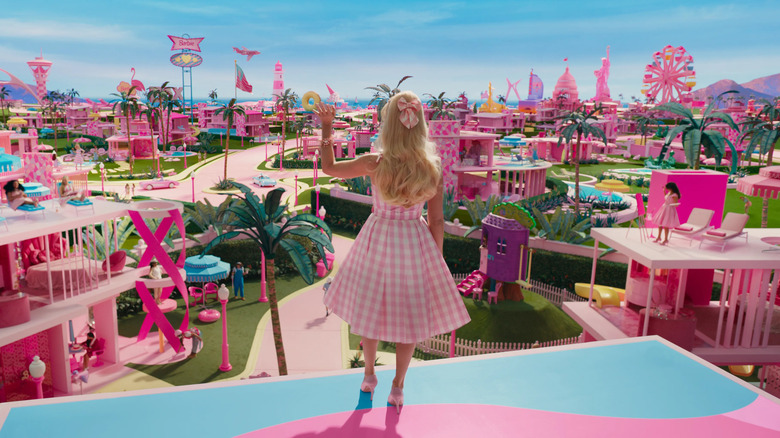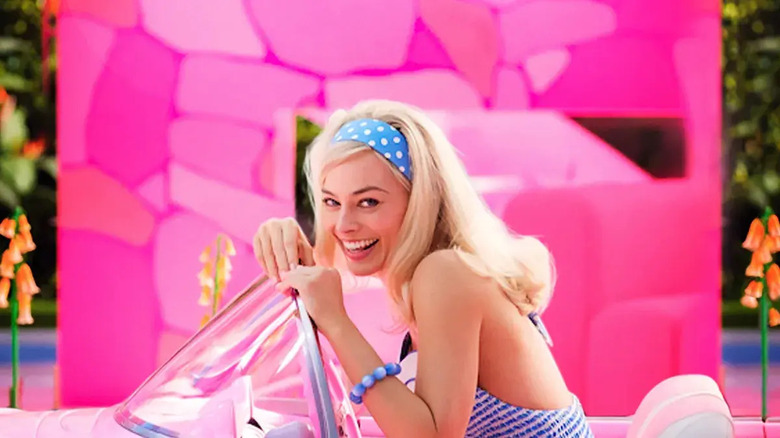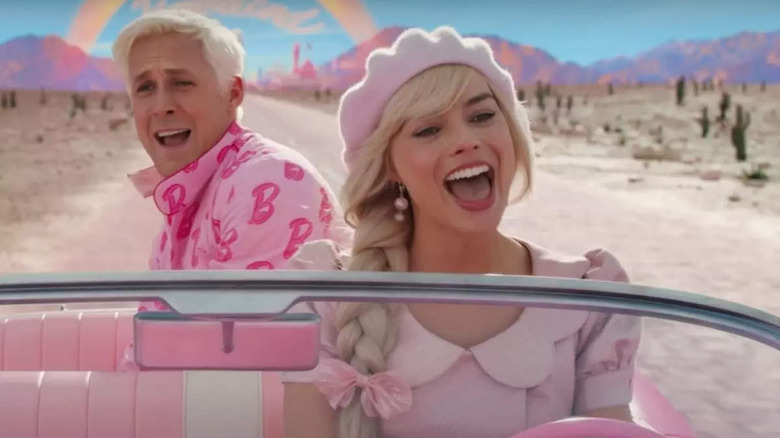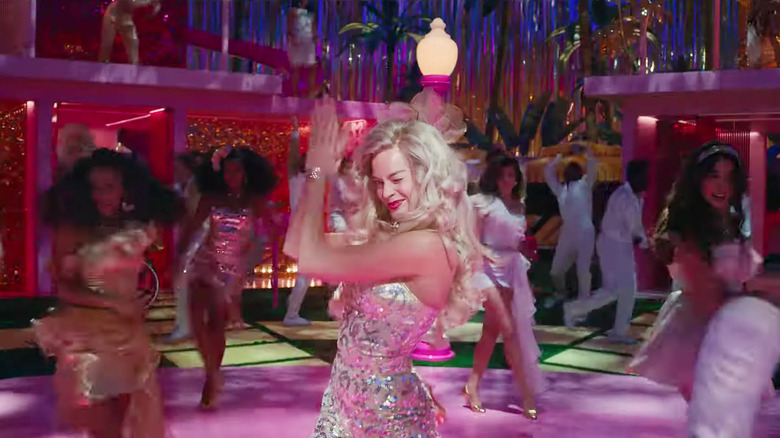How The Team Behind Barbie Built Those Astonishing Sets
I have a kind of second-hand nostalgia for Barbie. When we were growing up, my little sister had a bunch of dolls and she always wanted me to play with them. I wasn't into the usual stuff a six-year-old girl liked doing with Barbies, so I integrated them with my own toys. I found it far more fun to have Barbie teaming up with He-Man, Han Solo, and Action Man (the UK version of G.I. Joe) to storm Castle Grayskull and take out Skeletor, Darth Vader, and their cronies. Never known for their sharpshooting, Imperial Stormtroopers were no match for the rangy kicks and flying headbutts from a squad of highly motivated Barbie dolls.
Thanks to those fond memories of action-packed Barbie missions from my childhood, I'm seriously looking forward to the Mattel toy's big-screen summer outing this year. I've never felt the need to watch any of the animated versions of Barbie over the years, but Greta Gerwig's movie looks like the real deal. Margot Robbie and Ryan Gosling look irresistible as the eponymous character and her sweetheart Ken, and Gerwig, working from a screenplay co-written with her partner and long-term collaborator Noah Baumbach, is sure to tease out some more topical elements amid all the candy-colored fun.
The full trailer makes the film look like a cross between "The Truman Show" and "Elf" as Barbie, stricken with an existential crisis and human-like imperfections like flat feet, sets out from Barbie Land to find answers in the real world. The "Elf" connection is completed by the presence of Will Ferrell as a manic Mattel executive. One of the most striking aspects is the design of Barbie's ersatz world, which is very, very pink. So pink, in fact, that the production reputedly caused a shortage of the color.
A Barbie movie for everyone?
Barbara Millicent Roberts, better known as Barbie, was first launched by Mattel in 1959. For a toy, she has become a cultural mainstay that comes with a lot of baggage: In some quarters, she is seen as a feminist icon, while in others she is decried as an unrealistic and potentially harmful role model for young girls; in 2014, Medical Daily deduced that if she were a real woman, she would need to "walk on all fours and she would be physically incapable of lifting her over-sized Mattel head." With such criticism, the toy company had to up its game and has diversified its signature doll range in recent years, which now boasts 35 skin tones, nine body types, and Barbies with hearing aids and Down Syndrome. Margot Robbie, whose production company LuckyChap finally got the long-gestating project to the screen, acknowledged the public's love-hate relationship with Barbie in an interview with Vogue:
"We of course would want to honor the 60-year legacy that this brand has... But we have to acknowledge that there are a lot of people who aren't fans of Barbie. And in fact, aren't just indifferent to Barbie. They actively hate Barbie. And have a real issue with Barbie. We need to find a way to acknowledge that."
The full trailer sells the movie on this premise, playfully stating: "If you love Barbie, this movie is for you... If you hate Barbie, this movie is for you." There are arguably fewer writers and directors around today who are better suited to tackling these contradictions than Greta Gerwig, who has firmly established herself as a fresh feminist voice in an American film industry still dominated by men. Robbie ensured that she and Baumbach had full creative freedom with the screenplay, which made Mattel and Warner Bros somewhat nervous.
Creating Barbie's world
While the film seems tailor-made for the director of "Lady Bird" and her acclaimed modern take on "Little Women," the project goes back to much earlier. A "Barbie" movie has been in development since 2009 and things got interesting several years later when Amy Schumer was cast. The controversial comic and actor's involvement had a welcome subversiveness to it, but she walked away when the studio tried to dumb down her ideas.
After Anne Hathaway was briefly in the frame, Margot Robbie sealed the deal when she sold the prospect of her production company, LuckyChap, making the "Barbie" movie for Mattel. Robbie and Gerwig teaming up on the project has a reassuring feel to it; an Oscar-nominated actor and producer who has never let herself get typecast and an astute writer-director who has garnered significant acclaim already in her short career behind the camera.
They have clearly treated the film, which could easily become a one-note joke in lesser hands, with respect. During production, LuckyChap hosted "movie church" screenings for the cast and crew to nail down the look and vibe they wanted to achieve, including films like "The Red Shoes" and "The Umbrellas of Cherbourg." The research also extended to that paint-sapping set design.
With a budget of $100 million, Greta Gerwig really got stuck into the detail when it came to the production design of "Barbie." The stunning sets, which look like they are ripped out of a toy store catalog from around 1986, are so remarkable that they even warranted a feature from Architectural Digest about the design and influences of Barbie's perfectly pink world.
A global shortage of pink paint
To fully realize Barbie Land, Greta Gerwig enlisted the expertise of Production Designer Sarah Greenwood and Set Decorator Katie Spencer, both six-time Oscar nominees for their work together on films like "Atonement," "Anna Karenina," and "Darkest Hour."
Neither owned a Barbie Dreamhouse as a kid, so they bought one to study. Accordingly, they adjusted the scale of the set to match its unrealistic dimensions. Gerwig noted:
"The ceiling is actually quite close to one's head, and it only takes a few paces to cross the room. It has the odd effect of making the actors seem big in the space but small overall."
It wasn't just the Mattel back catalog that provided inspiration. The midcentury modernist architecture of Palm Springs and the style of "Pee-Wee's Big Adventure" also contributed to the film's overwhelmingly kitschy look. To complete the effect, the backdrop of sky and mountains was hand-painted rather than rendered in CGI, and important detail for Gerwig: "Everything needed to be tactile, because toys are, above all, things you touch."
The movie made headlines recently for causing a global shortage of fluorescent pink paint, produced by Rosco, a manufacturer that supplies Hollywood. Greenwood's claim that "the world ran out of pink" was substantiated by Lauren Proud, the company's Vice President of Global Marketing, albeit with a caveat. While she confirmed that the "Barbie" production had "used as much paint as we had," she also added that stockpiles were already pretty low in the wake of the pandemic and other supply chain issues. So there is the full story, although it is probably more fun to play make-believe, like I did all those years ago when I sent my sister's Barbies on their daring missions to Castle Grayskull, and pretend "Barbie" was solely responsible for a world shortage of garish pink paint.



